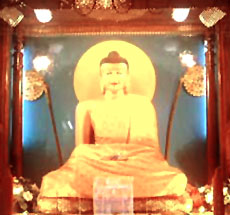 Konch is eighteen miles from Gaya It has many ruined temples, one such ancient temple is built entirely of bricks. The temple is a square building, 27 feet 6 inches square with the internal chamber being 11 feet square. The entrance is to the east and its height is 70 feet, and has two stories. The lower story is vaulted and has two arched roofs meeting in a ridge. Bricks overlap on all four sides and meet at a point. The door is as high as the room ceiling inside.
Konch is eighteen miles from Gaya It has many ruined temples, one such ancient temple is built entirely of bricks. The temple is a square building, 27 feet 6 inches square with the internal chamber being 11 feet square. The entrance is to the east and its height is 70 feet, and has two stories. The lower story is vaulted and has two arched roofs meeting in a ridge. Bricks overlap on all four sides and meet at a point. The door is as high as the room ceiling inside.
This temple is an engineering feat considering the era it was built in.
A look at the Konch temple reminds one of the Mahabodhi temple at Bodh Gaya. In fact this temple served as a model for the Mahabodhi temple. The Konch temple has its sides curved on the, upper portion and this temple has no niches. Each wall is divided into seven sections with deeply recessed upright lines. These are strongly pronounced, and the curved ornamentation is concealed with a coat of plaster. It has a lingam of Koncheswar Mahadeva. It looks as though a new floor was made at a later higher level, so the lingam seems to as if standing in a hollow. A small channel faces the north and carries off the oblation water poured over the lingam.
The temple is built of burnt bricks of different sizes. Some bricks measure 11" x 5" x 2", some 9" x 4" x 2" and others 13" x 7" x 2". The different sizes indicate the temple underwent extensive repairs. The entrance to the temple is a big opening in the face of the tower. It has vertical sides, spanned by an arch of overlapping small-sized bricks in the shape of a tall isosceles triangle with indented sides. This entrance is divided into two parts by a stone right across the lower rectangular. The lower portion lets you into the sanctum. The upper rectangle has a triangular opening and leads to the upper chamber. The tower has a cylindrical pinnacle with a hemispherical top. The upper portion also lets light to fall on the lingam. But new construction of the upper chamber, the entire interior has now become dark.
The statues and relics are Brahmanical. There are statues of Haragauri and the Ashta Saktis can be found inside the temple. The most important is a panel sculpture of the Dashavataras of Vishnu. But they are different from the Dashavataras represented in other temples. It divides the Vamana avatara into two sections by leaving out the ninth or the Buddha avatara and represents Vishnu in the tenth or Kalki avatara with a female deity with a small horse standing in front. These Dashavataras are beautifully sculptured. The fish incarnation is shown as a fish standing on its tail. The tortoise resembles a Saivite emblem of the argha and lingam has a couple of human figures on the sides holding a string being wound round the lingam - representing the Mount Mandar.











